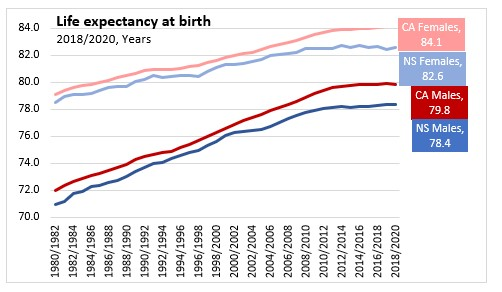
It has become more and more apparent that attacks on the standard of living are in reality attacks on life itself. Recent statistics reveal an emerging trend showing that life expectancy is on the decline in Canada. Our lives are not only diminishing in quality, but in quantity too. We are living shorter, more miserable lives, and capitalism is to blame.
Life expectancy on the decline
The National Post recently published a piece showing that the Canadian average life expectancy at birth for both sexes dropped from 81.90 to 81.63 between 2017 and 2021. A deeper dive into the national statistics shows that the decline in life expectancy is especially clear in some provinces. The Vancouver Sun reports that “B.C. was among several provinces, including Newfoundland and Labrador, Prince Edward Island, New Brunswick, Saskatchewan, and the Northwest Territories where there was an increase in deaths of at least 7.0 per cent in 2021.” In Saskatchewan, life expectancy has gone from 80.24 in 2017 to 78.48 in 2021.
Combined with the fact that life span numbers in Canada “have plateaued since the 2010s” after a steady upward trend in most of the last century, the evidence is damning: the era when Canadians could expect their lives to improve and to get longer is over.

What is causing this decline?
Many explanations have been put forward for this decline. Statistics Canada analyst Patrice Dion explains that life expectancy generally varies depending on “education level or income” and highlights in particular the rampant opioid crisis and rising deaths due to overdoses as part of Saskatchewan’s particularly acute decline.
University of B.C. professor Kimberlyn McGrail highlights the fact that B.C.’s “intense attention on COVID-19 worsened the province’s ability to cope with other emergencies, including the heat dome during the summer of 2021 and the continuing crisis of a tainted supply of street drugs” as a potential factor in B.C.’s decrease in life expectancy. While McGrail was reluctant to call this a trend, when taken with other statistics, the numbers on life expectancy paint a grim picture.
As a reminder, the heat dome McGrail refers to killed 619 people in a one-week span during the summer of 2021, but the province needing to focus on COVID is hardly the only reason why it got so bad. Air conditioning would have been an easy way to prevent people from dying of heat in their own homes but there was a reason why many weren’t able to obtain them: tenants in B.C. currently must obtain consent from their landlords to install them. This presents a wholly unnecessary ”barrier for low-income renters to get relief from the heat” and it has left landlords with blood on their hands.
In general, it is Canada’s most vulnerable who disproportionately die younger. In Alberta, the life expectancy of Indigenous people is around two decades below the Canadian average. As APTN news reports, “For First Nations men, a life expectancy of 60 aligns with the life expectancy of men in countries like Haiti and Bolivia. Both of which have a much lower GDP than Canada.”
Indigenous people in Canada also make up a disproportionate portion of the homeless population, with 30 per cent of homeless people coming from Indigenous communities, which make up less than six per cent of the total population. It will come as no surprise that life expectancy for homeless people is almost half of that of the general population. The median age of death for homeless men in 2022 was 55 years old compared to 79 for other Canadian men. The situation of homeless women is even more dire, with these women dying at a median age of 42 years versus the national median of 84. With steadily increasing homelessness in Canada, we can expect life expectancy to continue declining.
What is to blame for declining life spans across the country? From the opioid crisis to environmental disasters and inequality—among the array of explanations, there is one cause that ties them all together.
Capitalism is to blame
It’s capitalist landlords who prevent people from accessing the basic human right to shelter. It’s capitalist governments who put profits before people rather than taking the proper measures to stave off a global pandemic. It is they who shamelessly downplayed COVID-19’s death tolls after hacking away at healthcare for years. It is the capitalist system itself that has created the opioid crisis and the devastating climate catastrophe. The trend in declining life expectancy came to the fore in and around the COVID-19 crisis, but the pandemic was not merely an anomaly, but a catalyst that accelerated the underlying illness of a society in total decay, exacerbating its existing symptoms. The most damning symptom of all is the relationship between poverty and lower life expectancy.
The current capitalist crisis is one of the deepest in living memory. Spurred on in part by massive debt and rising inflation, it has now evolved into a growing cost-of-living crisis borne most heavily by the working class throughout the world. Canada is no exception. Its ruling class has deployed government-imposed austerity in an attempt to abate the effects of the crisis it creates. This all means attacks on healthcare, education and public transportation, rising costs of rent and food, and a general decrease in living conditions; an attack on life itself.
The verdict is clear: capitalism cannot sustain life. And a system that cannot sustain life does not deserve to survive itself. The overthrow of capitalism is, literally, a question of life or death.

